What’s with Lisa Murkowski’s voting “present” on Brett Kavanaugh’s confirmation?
It seems as if nothing in Brett Kavanaugh’s confirmation went according to script. The accusations of sexual assault, the testimonies, the pop-up FBI investigation, the many witnesses hoping to speak up about the Supreme Court nominee’s character and drinking habits—these aren’t typical Supreme Court Justice-confirmation happenings.


It seems as if nothing in Brett Kavanaugh’s confirmation went according to script. The accusations of sexual assault, the testimonies, the pop-up FBI investigation, the many witnesses hoping to speak up about the Supreme Court nominee’s character and drinking habits—these aren’t typical Supreme Court Justice-confirmation happenings.
The day of the vote was no exception. The only Republican US senator to oppose Kavanaugh’s confirmation, Lisa Murkowski, didn’t actually vote “nay”—or “yea” for that matter. In fact, her vote wasn’t registered at all in the final 50-48 tally. Instead, Murkowski voted “present,” a way to indicate she intended to “pair” her vote—that is, combine it with the vote of a colleague who would cast their ballot the opposite way if they there present, but is not, essentially canceling out both votes. In this case, Murkowski paired her vote with Republican Steve Daines of Montana, who was not able to attend the vote as he was, in Murkowski’s words, “walking his daughter down the aisle.”
“Pairing votes” can be done as a form of courtesy toward a colleague who can’t take part in the vote—as was the stated case with Murkowski and Baines—or to end the session more quickly, without waiting for late comers. In this case, for instance, Baines would have had to leave his daughter’s wedding, and the senators would have had to wait for him to make his way to DC.
This is a practice that exists outside the US, too. In the UK, for instance, it is employed on occasion so that members of parliament don’t have to follow every small vote and can focus on government work without the distraction of voting. For instance, there may be cases when a vote already has an ample majority, and voting members might prefer focusing on other priorities, perhaps in their own constituencies.
In the US, pairing votes is not very common, but it once was: It’s a traditional practice that used to be more regular when party lines weren’t quite as homogenous, and senators from the same party were more likely to vote in opposite ways. Research done on the frequency of vote pairings in the US found that it was most common in the early 1960s, when there was over 800 paired votes per year, but decreased dramatically after the 1970s, until it became all but nonexistent after the 1990s. Studies have shown that increased partisanship and polarization may be the reason behind the decreased frequency of vote pairing: it is just harder these days to find members of the same party voting in opposite ways.